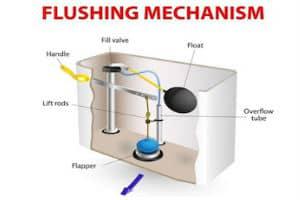How Long Do Toilets Last?
August 15, 2020
Depending on use, a good toilet may last you 50 years. Most toilets are made of porcelain, which lasts a long time. Certain components within the toilet may need to be repaired or replaced more frequently, however. Most of these can and should be replaced without replacing the whole toilet.
Ultimately, how long your toilet lasts depends on how long it continues to function effectively. There are several simple ways you can gauge both how old and how effective your toilet is just by checking different components. Here’s how you can find your own answers to questions about the age, status, and effectiveness of your toilet:
Does My Toilet Need to Be Replaced?
Some of the oldest known toilets date back to ancient Rome. While your toilet may not be around in 2,000 years, it will most likely have a respectable lifespan. Like a chain, however, a toilet is only as strong as its weakest link. Poor plumbing, leaky valves, worn flappers and deteriorating wax seals may be signs your toilet is due for and overhaul.
It may be time to consider toilet replacement if you’re experiencing issues like:
- Leaking
- Wobbling
- Increased water usage
- Mineral damage
- Frequent clogs
- Chips or cracks
- Low water pressure
Diagnosing the root of the problem may be as simple as installing a new flapper and as complex as replacing your sewer stack. A trusted plumber can advise you on the best return for your investment.
How Do I Know How Old My Toilet Is?
Manufacturers often stamp the date when your toilet was made on the inside of the tank lid. By carefully lifting the lid off the tank and flipping it over, you should be able to determine how old your toilet is. Sometimes the stamp is found on the tank itself just above the water line.
What Parts of My Toilet Need Replacing?
The two main visible components of your toilet are the tank and the bowl. These are typically the last things you’d need to replace. They are hard porcelain, which resists bacteria and is easy to clean.
Within the tank are several parts that release water when you flush and then refill for the next use. Above and below the bowl are the parts that direct the flow of water and waste.

- Theflapper is the rubber valve that opens when you pull the flush handle. It is connected by a small chain to a lift rod and allows the water to drain into the bowl when opened. When the water is all drained, the flapper closes and the tank refills. If your toilet is “running” it usually indicates a worn flapper that no longer properly seals the valve between the tank and bowl.
- The overflow tube is a chamber connected to the water supply that refills the empty tank. A float attached to the refill tube rises with the water and shuts off the supply when your tank is full again.
- An O-ring seal connects the tank to the bowl and facilitates the water transfer. This could become a potential leak source over time.
- A wax seal and floor flange connect the base of the bowl to the floor and the sewer stack where waste is transported. This is another area where time and use may create wear and leaks.
All these components will most likely require attention at some point in your toilet’s life. Choosing to replace the entire toilet is a bigger decision but may be your best option.
Reasons to Replace Your Toilet
There are many reasons to replace your toilet beyond wear and tear. Every kingdom deserves a proper throne, and after all, you spend time on it daily. Here are a few things to consider as you weigh your investment:
- Efficiency. Toilets account for nearly 30% of water use in your home. That’s a big consideration for your water bills. In 1994 the EPA mandated greater efficiency standards, with a maximum use of 1.6 gallons of water per flush. Recent advancements have allowed for flushes that use only 1.28 gallons/flush. Look for the WaterSense label to identify these highly efficient toilets.
- Comfort. One size doesn’t fit all. The standard toilet height is 15” but if you’re a taller person, a 17” height may suit you better. There is also a matter of round vs oval bowls, with oval regarded as the more satisfying seat. Which is better for you?
- Water pressure. There are several types of flushes available these days. Dual flush toilets have separate flushes for solid vs liquid waste. Pressure assist toilets provide more force than gravity-fed toilets for a stronger flush. Smart toilets add built-in features like heated seats, bidets and air dryers.
- Aesthetics. Upgrading your bathroom is always a sound way to increase your home’s value. A brand-new stool can make old bathrooms feel new again and add lasting value to your home. Match the style and color to your bathroom as part of a larger remodel.
Talk to a qualified plumber to find out what toilet makes the best sense in your home.
How Do I Replace My Toilet?
Don’t settle for a backseat. You want your new toilet to last-maybe for 50 years. Trust this important job to a certified plumber who will ensure that your toilet works smoothly and efficiently for years to come.
A skilled technician from Ben Franklin can evaluate your old toilet and advise you on the best path toward repair or replacement. If it’s time to replace, we’ll professionally install the best toilet for your budget and home.